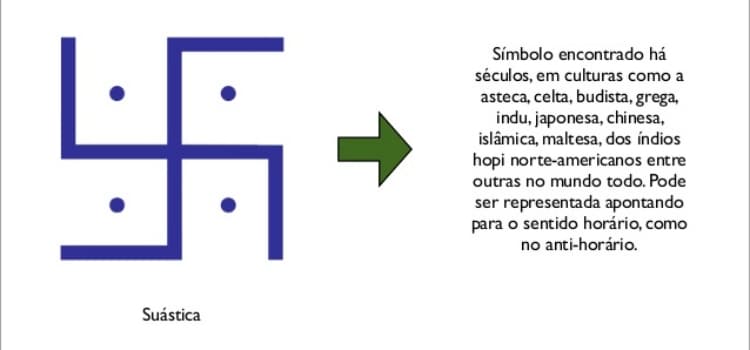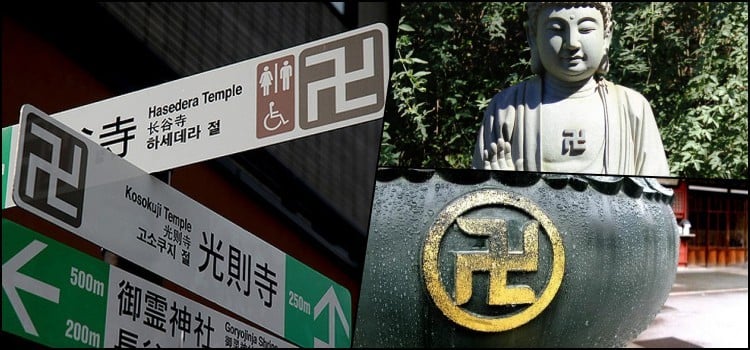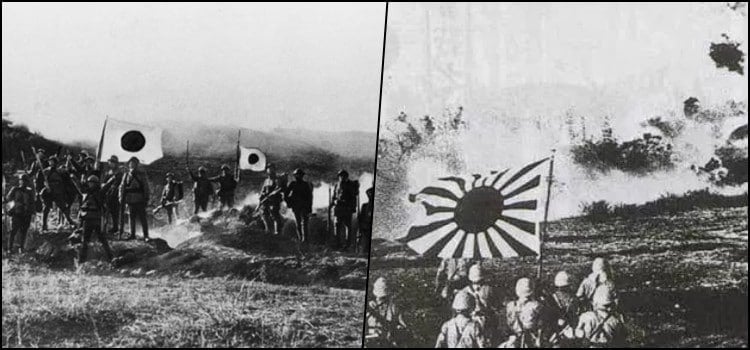Many Westerners are unaware that the swastika is not unique to Nazism. There are several types of swastika and each one has its meaning. Do you know the difference between the Nazi swastika and the Buddhist swastika?
In the West, the swastika gained a very negative aspect due to its popularization through the flag of the Nazi Party that ruled Germany between 1933 and 1945.
The Nazis used this symbol on their flag to represent the identity of the Aryan Race and as a result this symbol was stigmatized in Europe and the Americas as a symbol of racism and hatred.
However, even before the Nazis used the swastika, this symbol had been used in Asia for over 5,000 years. It was used mainly in India, in the Hindu religion. It was also used in Jainism and Buddhism.
The swastika was so popular that it was even used in Norse culture to represent the energy of Thor's hammer. It was even used in cathedrals and ornamental clothing to represent the Cross of Christ. It was even used in the US by Indian tribes.
Índice de Conteúdo
What is the origin of the swastika?
It is not known which people used the swastika for the first time, but its origin is quite old and dates back to 3,000 BC. It is considered one of the oldest symbols in the world. This symbol was found in several parts of the world being used both clockwise and counterclockwise. All had positive meanings!
The name “swastika” is derived from the Sanskrit word (ancient language of India) “majiyabai“, which basically means “well-being”.
In Asia, the swastika has always been linked to Indian religions and the use of this symbol spread across Asia thanks to Buddhism as it represented fortune, long life and was even a representation of the Buddha himself.
On these occasions, the swastika has another meaning. In Buddhism, the swastika symbol is considered an auspicious footprint of the Buddha. It is an aniconic symbol for the Buddha in many parts of Asia and a counterpart with the wheel of dharma. The shape symbolizes eternal cycling, a theme found in the samsara doctrine of Buddhism.
The intention of the article is precisely to explain that the swastika did not have its origins in Nazism and that it already had a meaning even before Nazism existed. In Japan this symbol is called Manji (万字).

Manji - The swastika in Buddhism
In Buddhism, the swastika is almost always clockwise. It signifies auspiciousness and fortune, as well as the Buddha's footprints and the Buddha's heart. The Buddhist swastika is said to contain the entire mind of the Buddha and can often be found imprinted on the chest, feet or palms of Buddha images.
The manji represents the balance of opposites, universal harmony, good luck and eternity. Each axis of the Buddhist swastika means one thing:
- Vertical axis - Represents the junction of heaven and earth;
- Horizontal axis - Represents the connection of yin and yang;
- Four Arms – Represent the interaction, movement, and revolving force of the elements;

The Buddhist swastika symbol is common in the esoteric traditions of Buddhism, along with Hinduism, where it is found with Chakra theories and other meditative aids. The clockwise symbol is more common, and contrasts with the counterclockwise version common in the Tibetan Bon tradition and locally called yungdrung.
It is also the first of 65 auspicious symbols in the Buddha's footprint. The swastika was also used to mark the beginning of Buddhist texts. In China and Japan, the Buddhist swastika was seen as a symbol of plurality, eternity, abundance, prosperity, and long life.
If you access Google Maps of Japan you will find this symbol in several places identifying the location of a Buddhist Temple.

The Buddhist swastika is used as an auspicious mark in buddhist temples and is especially common in Korea. It can often be seen in the decorative borders around paintings, altar cloths and banners. In Tibetan Buddhism, it is also used as a garment decoration.
In addition to this definition, the symbol when turned to the left also represents love and mercy. And when turned to the right, it represents strength and intelligence. The most common in Japan is to find the sign facing left.
The swastika in Nazism
The swastika was widely used in Europe in the early 20th century. It symbolized many things to Europeans, with the most common symbolism being good luck and auspiciousness. Amid widespread popular usage, in post-World War I Germany, the newly created Nazi Party formally adopted the swastika as a symbol of Nazism.
The Nazi swastika was adopted as an Aryan symbol indicating racial purity and superiority. The Nazi swastika is usually black, turned 45 degrees to the right with the corners pointing up.

The Nazi Party adopted the swastika in 1920, the red of the flag represented socialism, while white represented nationalism. It's amazing how the Nazis smeared the name of a symbol over 5000 years old in just 30.
There may also be a connection to the swastika's magical connections. Hitler and other Nazi leaders were interested in the occult. The Nazi swastika is counterclockwise. The worst thing is that it is easy to associate the swastika found in Japan when we remember Nazism.
The article is still halfway through, but we recommend also reading:
The swastika written in Japanese
Throughout the article we can see several differences between the two swastikas, but to be a little more technical, let's study Japanese writing a little?
In the Japanese language any swastika is called a manji the traditional one being referred to as hidarimanji [左卍] and the inverted one as migimanji [右卍]. It is worth remembering that neither of them are Nazis.
In fact, the Nazi Swastika does not represent anything negative, just the inverted swastika turned slightly at a 45 degree angle that becomes Nazi.
The Nazi swastika is called Hakenkreuz [ハーケンクロイツ] or Kagi-juuji [鉤十字]. The Japanese don't usually have the stigma, even though they had a part in Nazism, for them it's simply a common religious symbol.
The post-WWII stigma
Due to its use by Nazi Germany, the swastika since the 1930s has been widely associated with Nazism. After Second World War, was considered a symbol of hatred in the West, or of white supremacy in many Western countries.
As a result, its entire use is banned in some countries, including Germany. Because of the stigma attached to the symbol, many buildings that used the symbol as decoration had the symbol removed.
Nowadays it's hard not to see the Buddhist swastika on Google and not remember Nazism. How can a peace symbol be able to remind us of something so dark?

Western misinterpretation of the use of the swastika
Since the late 20th century, confusion has occurred when consumer goods bearing traditional Jain, Buddhist or Hindu symbols were exported to the West. Eventually it was interpreted by consumers as having a Nazi symbol. This resulted in several of these products being boycotted or taken off the shelves.
When a ten-year-old boy in New York drew a set of cards from Pokémon imported from Japan in 1999, two of the cards contained the left-facing Buddhist swastika. The boy's parents misinterpreted the symbol as the Nazi swastika and filed a complaint with the manufacturer.
Nintendo's American branch announced that the cards would be discontinued. The branch explained that what was acceptable in one culture was not necessarily so in another.
In 2002, Christmas cookies containing toy pandas with swastikas were pulled from shelves after complaints in Canada. The manufacturer said the symbol was presented in the traditional sense and not as a reference to the Nazis.
Even today people can misinterpret this symbol. It was even considered changing the symbol used in Japan so as not to confuse people at the 2020 Olympics, but they decided to keep a symbol and leave notices explaining its true meaning.
Did you know the true meaning of the swastika? What did you think of the article? If you liked it, share it with your friends and leave your comments.
The Meaning of the Character 卍 in Manga and Writing
It is common to find the character 卍 written in manga dialogues or elsewhere. What is the meaning of the Buddhist swastika in writing?
Most of the time, it's a slang used by teenagers that basically means nothing, synonymous with yabai which also means nothing.
A popular example is the phrase maji-manji [マジ卍] which is practically the same as majiyabai which serves as an exclamation used when encountering something amazing, exciting, or even terrible, usually used by high school girls.

The swastika is more present in Japanese culture than you might think. We recommend reading below the article that shows the swastika in Japanese culture, anime and manga.







